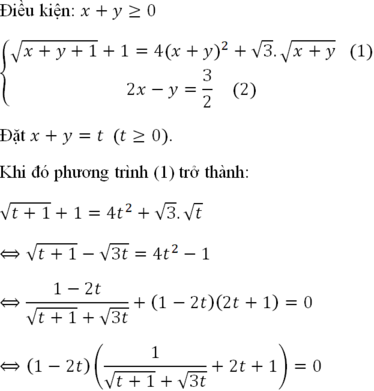Cho hệ phương trình có nghiệm duy nhất Khi đó x.y bằng
Hãy nhập câu hỏi của bạn vào đây, nếu là tài khoản VIP, bạn sẽ được ưu tiên trả lời.


Ta có: \(\hept{\begin{cases}\left(\frac{1}{x}+y\right)+\left(\frac{1}{x}-y\right)=\frac{5}{8}\\\left(\frac{1}{x}+y\right)-\left(\frac{1}{x}-y\right)=-\frac{3}{8}\end{cases}\Leftrightarrow\hept{\begin{cases}\frac{2}{x}=\frac{5}{8}\\2y=-\frac{3}{8}\end{cases}\Leftrightarrow}\hept{\begin{cases}x=\frac{16}{5}\\y=-\frac{3}{16}\end{cases}}}\)

1. \(2x^2-3x-5=0\)
\(\Leftrightarrow\left(2x-5\right)\left(x+1\right)=0\)
\(\Leftrightarrow\orbr{\begin{cases}2x-5=0\\x+1=0\end{cases}}\)
\(\Leftrightarrow\orbr{\begin{cases}x=2,5\\x=-1\end{cases}}\)
Vậy tập ngiệm của phương trình là \(S=\left\{2,5;-1\right\}\)
2x2-3x-5=0
2x2+2x-5x-5=0
2x(x+1)+5(x+1)=0
(x+1)(2x+5)=0
TH1 x+1=0 <=>x=-1
TH2 2x+5=0<=>2x=-5<=>x=-5/2
2. ta có:
2(x-2y)-(2x+y)=-1.2-8
2x-4y-2x-y=-2-8
-5y=-10
y=2
thay vào
x-2y=-1 ( với y=2)
<=> x-2.2=-1
x-4=-1
x=3


Thay k=1 và HPT ta có:
\(\left\{{}\begin{matrix}x+y=3.1-2\\2x-y=5\end{matrix}\right.\)
⇔\(\left\{{}\begin{matrix}x+y=1\\2x-y=5\end{matrix}\right.\)
⇔\(\left\{{}\begin{matrix}2x+2y=2\\2x-y=5\end{matrix}\right.\)
⇔\(\left\{{}\begin{matrix}2x+2y=2\\3y=-3\end{matrix}\right.\)
⇔\(\left\{{}\begin{matrix}x=2\\y=-1\end{matrix}\right.\)
Vậy HPT có nghiệm (x;y) = (2;-1)
b) tìm k để hệ phương trình có nghiệm ( x ; y) sao cho \(x^2-y-\dfrac{5}{y}+1=4\)
\(\left\{{}\begin{matrix}x+y=3k-2\\2x-y=5\end{matrix}\right.\)
⇔\(\left\{{}\begin{matrix}y=3k-2-x\\2x-\left(3k-2-x\right)=5\end{matrix}\right.\)
⇔\(\left\{{}\begin{matrix}y=3k-2-x\\2x-3k+2+x=5\end{matrix}\right.\)
⇔\(\left\{{}\begin{matrix}y=3k-2-x\\3x=3k+3\end{matrix}\right.\)
⇔\(\left\{{}\begin{matrix}y=3k-2-x\\x=k+1\end{matrix}\right.\)
Ta có \(\text{ x= k+1 }=>y=2k-3\) (*)
Thay vào biểu thức đã cho ở đề bài ta có :
\(x^2-y-\dfrac{5}{y}+1=4\)
⇔\(\left(k+1\right)^2-2k+3-\dfrac{5}{2k-3}+1=4\)
⇔\(k^2+2k+1-2k+3-\dfrac{5}{2k-3}+1=4\)
Sau một hồi bấm máy tính Casio thì ra k=2
Vậy k=2 thì Thỏa mãn yêu cầu đề bài


ĐKXĐ: ...
Đặt \(\left\{{}\begin{matrix}\sqrt{x+2}=a\ge0\\\sqrt{y}=b\ge0\end{matrix}\right.\) thì pt đầu trở thành:
\(a\left(a^2-b^2+1\right)=b\)
\(\Leftrightarrow a\left(a-b\right)\left(a+b\right)+a-b=0\)
\(\Leftrightarrow\left(a-b\right)\left(a^2+ab+1\right)=0\)
\(\Leftrightarrow a=b\Rightarrow\sqrt{x+2}=\sqrt{y}\Rightarrow y=x+2\)
Thay xuống pt dưới:
\(x^2+\left(x+3\right)\left(x+3\right)=x+16\)
\(\Leftrightarrow2x^2+5x-7=0\Rightarrow\left[{}\begin{matrix}x=1\Rightarrow y=3\\x=-\dfrac{2}{7}\left(loại\right)\end{matrix}\right.\)


Đáp án: A